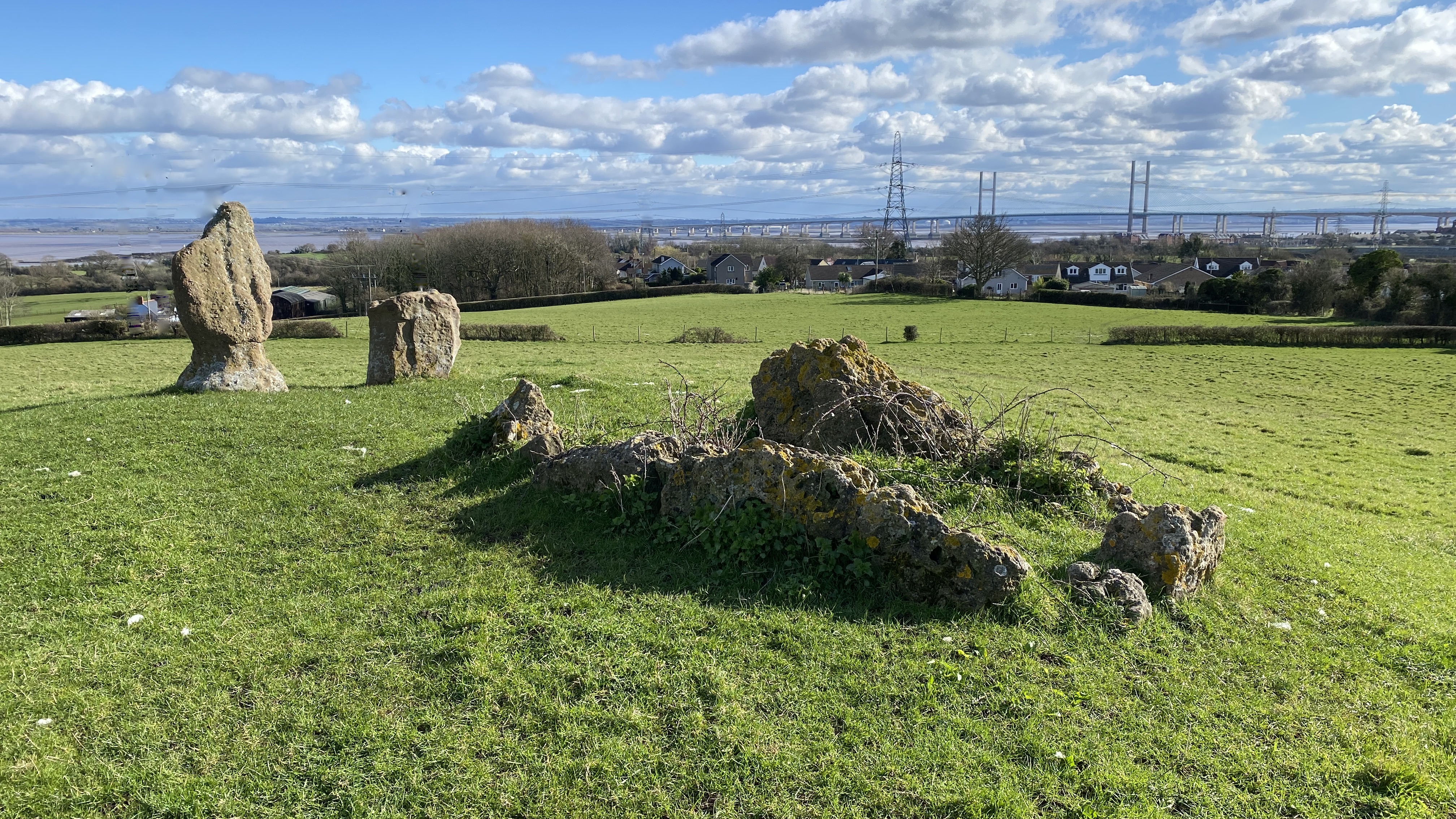Aunty was away for the weekend and so this gave me the opportunity for some solo exploration of a Neolithic burial chamber not so far from home. Whilst Aunty tolerates my fascination with ancient monuments, it’s not an activity that is actively encouraged. Though I have been accused of having an internal ‘tomb radars as I occasionally redirect our walk on a slight detour. But this time I had the place to myself and could take time to look around.

Heston Brake (more on the name later) is very much a skeletal remains of a burial chamber siting on a small hill outside Port Skewitt, Gwent. Small the hill maybe but it stands clear of the Gwent levels and the Severn Estuary flood plains. And because the Gwent Levels, are well …. level, there is a clear and uninterrupted view over the southern aspect from the burial chamber. So when constructed it provided a clear indication to the surrounding neighbourhood this was a special place even though it is only 35 meters above sea level. But when originally built the sea level was lower than today and the plains to the south would have been more extensive.

Heston Brake is classified as one of the Cotswold-Severn Group of monuments, and may have been constructed in two phases. However, there are only a few stones left standing today. When the chamber was initially exposed in August 1888 by members of the Monmouthshire and Caerleon Antiquarian Association (MCAA) and the Clifton Antiquarian Club, the notes of the excavation show more stones than those currently present1. The plan of the chamber and passage suggested that Heston Brake may be a gallery grave, one of only two in Wales. However, the classification is still debated. The stones are conglomerate sandstone or puddingstone, looking similar to soft a dirty yellow-orange concrete. This type of stone formation is very prone to erosion, leading to the stones now having very irregular shapes.

The chamber is aligned east to west, and measures 25m long, 12m wide and height averaging 1m23. Orientated almost due East to West, there were originally 15 stones, but some of those have been removed over the years. The largest two stones, are positioned at the East side of the tomb, giving the sense of an entrance. Compared with other long chambered barrows the stones at Heston Brake are not as massive, with the tallest being about 1.5m. Compare this with the enormous stones used at Tinkinswood. Intriguingly two of the side stones have holes in them, and not surprisingly have led to much conjecture as to their original purpose. From allowing the ancestral spirits to enter or leave the tomb to allowing food or offerings to be made to the spirits. The stones that covered the tomb are long gone and imagination is now needed to visualise how it would have appeared to those venerating their ancestors.
When the original excavators explored the tomb in 1888 they concluded that it had already been disturbed in the past and they found very few artefacts remaining. But they did find three pieces of human jaw, one of which still had three teeth attached, several separate teeth, and some small damaged bones. All were at the inner end of the chamber to the west. They also found a few fragments of a coarse pottery urn, outside the tomb to the north a few more bones 4.

It is thought that the final tomb is made up of two chambers built at different times. The two chambers are not directly in line but are placed end to end and are even of different levels, although they are intercommunicating. Possibly the western chamber (about 9 feet in length) was added to the eastern and earlier chamber, which is about 13 feet in length. However Nash5 doesn’t mention this as such, and suggests that the arrangement of the chamber and passage may be a design feature restricting visual access between outside and inside of the monument. It is difficult to identify features 4000 years after the tomb was first built. We seen already that there is some uncertainty over the type of tomb, not surprising considering the long time period over which they were built. Consider the interpretation and classification of burials and sacred sites over the past 2000 years up until today.
But why the name Heston Brake? It doesn’t appear to be Welsh, and this far in east Wales is unlikely to be. The influence of the English has been long and it has been suggested that Heston Brake is a corruption of a settlement known as Herberdston. Whatever the origin of the name, and the debate over the tomb type, it is worth a visit, and taking a few minutes reflection. Look at the major modern engineering projects of todays bridges over the wide waters of the Servers Estuary and compare them with the engineering challenges our ancestors of 4000 years ago must have faced in building Heston Brake as they made as statement on their land.
Visited: March 2022. Os grid reference: ST 5052 8867
- Bagnall-Oakeley, W. (1888) The Chambered Tumulus at Heston Brake. Clifton Antiquarian Club. accessed 22 May 2022. ↩
- Heston Brake. Coflein. https://coflein.gov.uk/en/site/300078/ accessed 22 May 2022. ↩
- Whittle, E. (1992) A Guide to Ancient and Historic Wales: Glamorgan and Gwent. HMSO: London. ↩
- Heston Brake. Coflein. https://coflein.gov.uk/en/site/300078/ accessed 22 May 2022. ↩
- Nash, G. (2006) The Architecture of Death. Logaston Press. ↩
